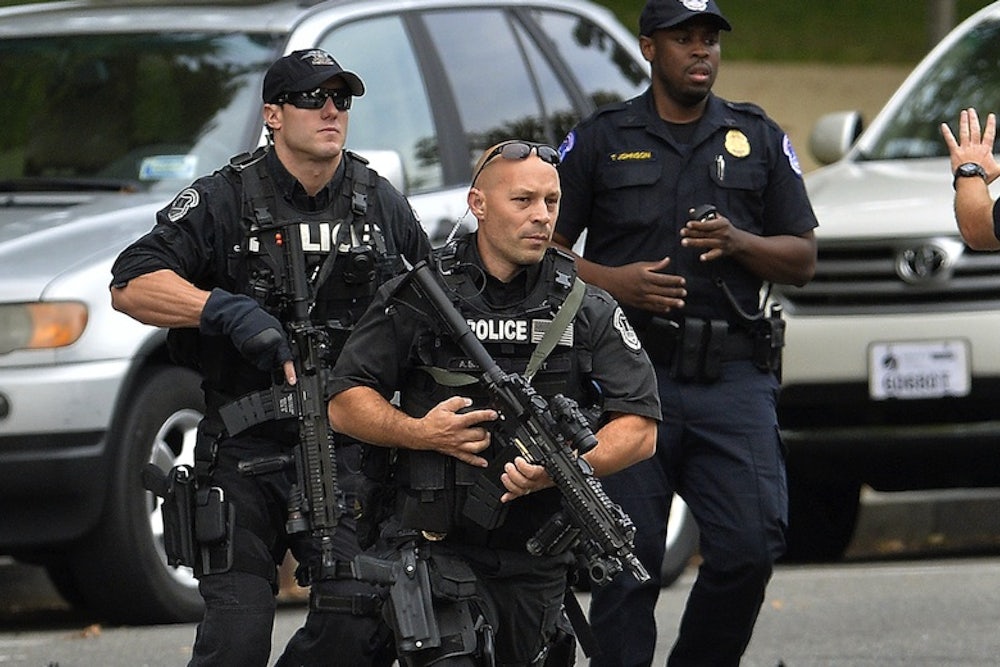It all came and went so quickly—panicked reports of a shooting outside the Capitol, a lockdown (Kansas Republican Sen. Pat Roberts even seized a commemorative knife!) and then the word that it was all over, with a lone perp “in custody,” which turned out to mean in the custody of the Lord. The relief within the Capitol gave way to huzzahs for the police who had put an end to the threat: Speaker John Boehner tweeted “We all owe the Capitol Police a debt of gratitude for their work every day; no finer examples of professionalism & bravery” (never mind that the government shutdown has imperiled their pay), the House gave a standing ovation to the Capitol Police and Senate staffers even handed out black buttons with a picture of the Capitol dome and the words, THANK YOU, CAPITOL POLICE.
Meanwhile, somewhere in the bowels of the state, sat a toddler plucked from the speeding car. She was “unharmed,” headlines assured us—aside from, you know, having lost her mother.
Am I the only one left disquieted by this neatly-wrapped episode?
I’m no expert in police procedure—far from it. But I have enough of the reporter’s innate skepticism toward authority to be wary of letting this drama pass unnoticed—not just the security response, but the response to the response by my colleagues in the press. The fact is, a woman with no weapon but the black Infiniti she was careening around in was shot dead—apparently, if reports are correct, as she was trying to flee the car after having previously refused to leave it.
Yes, cars can be deadly weapons (although some police departments, including the District of Columbia’s own municipal force, are discouraged against shooting at cars, a policy that dates back to a 1998 Washington Post investigation, and that I saw no mention of in today’s coverage). And yes, this driver was behaving extremely erratically, putting at risk herself, her daughter and everyone in her path. And yes, the various security agencies in the capital are understandably on edge right now after the Navy Yard shootings and more than a decade of counter-terrorism ratcheting, not to mention the gunman in 1998 who killed two Capitol police officers. As Josh Marshall put it in a post approving of the response: “If you flee toward the US Capitol and resist arrest, I think you've probably signed your death warrant unless you very clearly surrender…I don't think it's surprising when you understand or have experienced the intense security posture that surrounds the main government installations in DC - the White House, the Capitol Building, the congressional office buildings, etc. That chase from the White House wasn't a traditional chase and apprehension, probably more like a hunt, with threat elimination as its primary goal.” He adds a moment later: “Given what was known and her behavior, it makes perfect sense to me that the Capitol Police and whatever other federal authorities were in the mix were focusing on threat elimination as their primary goal rather than apprehension.”
But it’s precisely that plausible explanation that troubles me—that we’ve gotten to the point where it’s simply to be expected that such an episode would result in “threat elimination” by our extraordinarily heavily-armed security forces. I don’t mean to pick on Marshall here—he, at least, took the time to revisit the episode, whereas many other reporters simply moved on after learning that the “active shooter” they had been tweeting about was neither a shooter nor active but rather unarmed and dead.
My disquiet is not unlike what I was left with after the climactic ending of the Marathon bomber manhunt in Boston. There were even greater huzzahs then for the police’s victorious shootout with the younger brother trapped in the boat. Only much later did we learn that the shootout had been entirely one-sided—the cops mistakenly thought the fugitive had fired on them and opened fire on him, despite the fact that there was such a premium on capturing him alive. In fact, it turned out that he did not even have a gun on him. This should not have been such a surprise—he had fled on foot in a panic the night before amid the encounter with police that killed his brother. Yet authorities had decided to shut down a metropolitan area with one million people to seek him out—a decision that, again, got relatively little scrutiny after the fact.
Police do heroic things to keep us safe, often. They deserve to be paid, and paid well. But it’s one of the costs of living in a country bedeviled by both mass shootings and terrorism anxiety that we’ve become so unquestioning and obeisant in these moments when their overwhelming force is brought to bear—that we’ve become so used to the “shelter in place” order that we seem to remain in our place even after the order is lifted, without so much as daring to ask about the 17 bullets fired at a depressed dental hygienist going berserk in her car.
